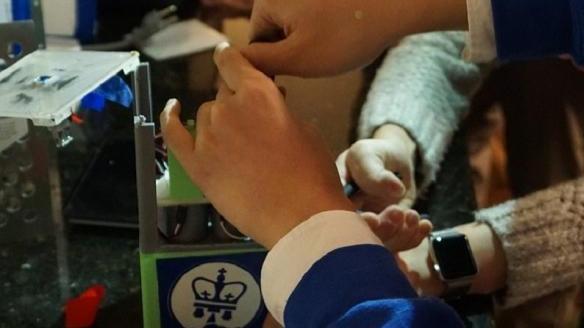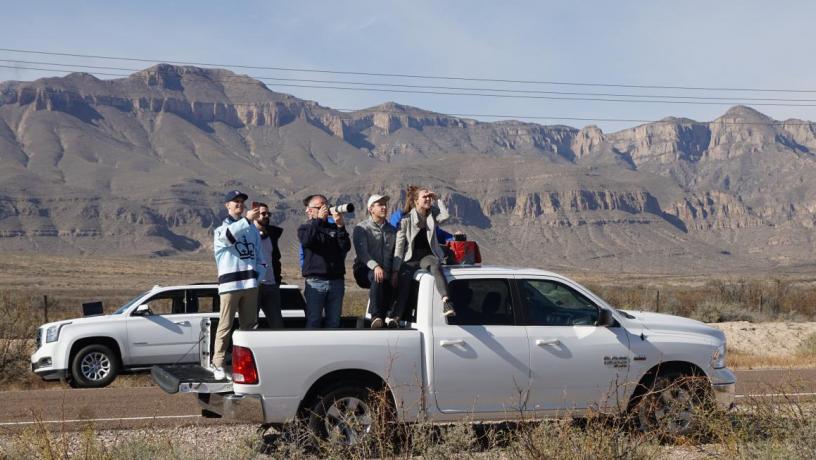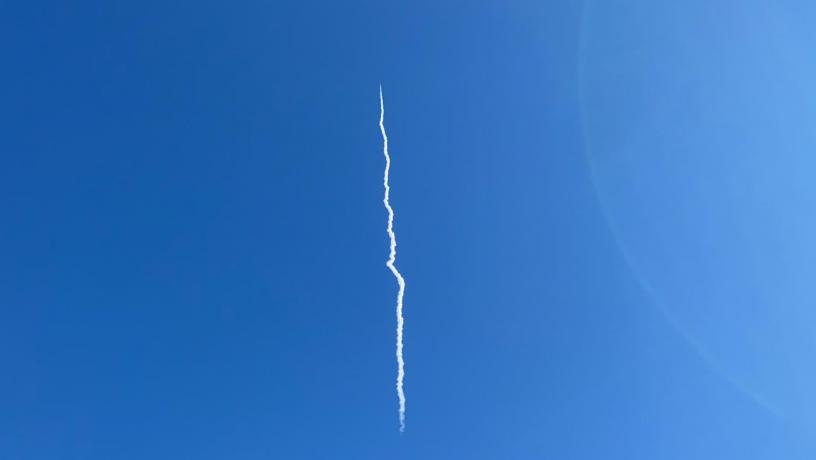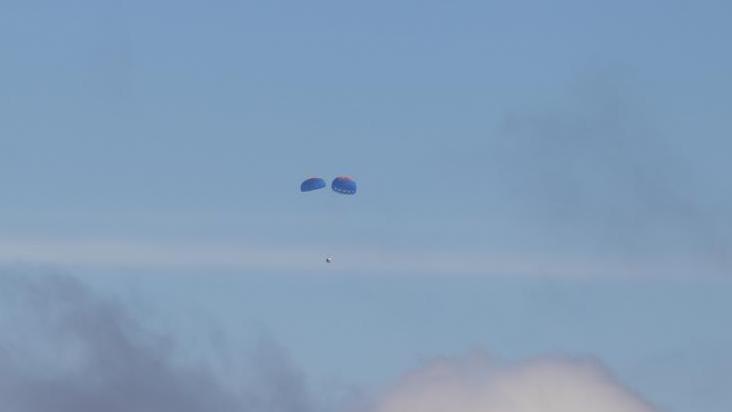To Infinity and Beyond: Columbia Space Initiative’s Zero-G Research Division Hitches a Ride on Blue Origin’s New Shepard Mission
To Infinity and Beyond: Columbia Space Initiative’s Zero-G Research Division Hitches a Ride on Blue Origin’s New Shepard Mission
The sky is most definitely not the limit for the Columbia Space Initiative’s Zero-G Research Division, which launched its first ever payload into outer space on Blue Origin’s New Shepard Mission NS-12 on December 11, 2019. Tucked into a small metal box, the biomedical experiment explores the acute impact of microgravity environments on cell biology, insights crucial for the future of humans living and working in space.
“With the rocket’s altitude reaching nearly 100 kilometers, our experiment traveled beyond the Karman Line, the boundary between Earth’s atmosphere and outer space,” explains Nathalie Hager, SEAS 2021 and Zero-G Research Division Lead. “Our project spent around 4 minutes in this microgravity environment, providing an exciting opportunity to conduct a scientific experiment.”
The Zero-G Research Division is a sub-team of the CSI, a student club dedicated to all things space and space technology. Launched in 2015, CSI was formed by a group of students who approached Columbia Engineering Professor Michael Massimino, BS ’84, a former NASA astronaut, to help them form a club that reflected their interest in space and to serve as the club’s advisor. CSI serves as an umbrella organization for mission teams involved in everything from nanosatellite mechanical design to hosting space policy forums.
The 2019 Mission
“We began planning the payload in the summer of 2018,” explains Nathalie. “Over one and a half years, our four sub-teams – Biomedical Engineering, Mechanical Engineering, Electrical Engineering and Computer Science - developed the entire experiment design together from scratch, secured funding for the development of our payload and for the launch fees for a spot on New Shepard, and successfully secured a spot on the P9 flight of Blue Origin’s rocket.”
Initially, the team considered very different ideas for the payload, ranging from laser beam power transfer research to studying particle robots in microgravity, before settling on the cell culture experiment. “We had several meetings with our faculty advisor, Professor Mike Massimino, who had offered many useful insights regarding payload and launch logistics that we incorporated into the final payload design,” says Luke D’Cruz, SEAS 2021 and Mission Lead. “The biggest challenge we overcame was developing a project within the given weight constraints (a maximum of 1.1 lbs.) that will yield meaningful results with only 4 minutes of exposure to microgravity.”
Ultimately, the team chose an experiment that sought to explore the effects of microgravity on certain proteins in rodent eye tissue. “Human spaceflight has been shown time and again to impose a variety of negative effects on the body,” explains Nathalie. “Looking specifically at eye function, about 30% of astronauts on short-term flights and 60% on long-duration missions to the ISS have reported impairment to their vision. As future missions for astronauts are planned and space tourism nears the realm of possibility, it is essential to develop a deeper understanding of the possible repercussions to human safety.”
Building off of previous research on the topic, the team aimed to explore the effects of true short-term microgravity exposure on eye tissue at a gene expression level, with particular interest in processes that affect the structural integrity of retinal glial cells.
Working closely with Professor Clark T. Hung, Professor of Biomedical Engineering, the team designed the experiment, and by the fall of 2019, they had a flight-ready payload that was designed to house cultured cells and inject a solution of RNA stabilizing solution at two time-points immediately before and after microgravity exposure. “All Parts were 3D printed in PLA except the outside shell which was aluminum sheet metal with CNC machined holes.” explains Luke. “Material was removed based upon topology simulations to produce highest strength to weight ratio. Two linear actuators were used to push fluid into six cell cultures. These cell cultures were housed in a 3D printed container filled with aerogel to minimize heat loss from the system.”
Post-launch, the team analyzed the findings by comparing the experimental cell sample group to a control. The comparison yielded 6 genes that were significantly affected by microgravity exposure. “Because the rodent eye and retina share similarities with their human counterparts, we hope that our findings will be beneficial for scientists studying the effects of microgravity on human vision,” says Luke. “I am excited to see where this research goes in the future.”
The team found their experience thrilling and educationally invaluable. “Spaceflight-based projects foster unconventional and outside the box thinking that you won’t really get anywhere else,” says Chris. “Rather than working in a perfect environment, you’re working in unique spaces with unique constraints. We had to put the finishing touches on the payload in the back of a minivan in Van Horn, Texas. I had to keep the cells warm, like a mama hen with her eggs, on a cross-country flight from NYC to El Paso. We had to design a system that was able to both keep the cells alive and preserve them at certain time points in a 10x10x20cm box that couldn’t weigh more than 700 grams. It’s this type of atypical environment that can foster the most groundbreaking ideas.”
“We spent 1.5 years quietly developing this payload in Mudd, and suddenly media like Forbes, TechCrunch and Space.com were writing about it,” says Nathalie. “It was pretty thrilling when Jeff Bezos mentioning our payload alongside a NASA payload on his Instagram.”
“This project really shows that teamwork is everything,” adds Nathalie. “From meeting up until midnight in Mudd, to assembling parts of the payload, to flying to Texas right during reading and finals week to be part of the on-site CSI payload support team, CSI’s members have shown their commitment and excitement for this project.”
The 2020 Mission
For the 2020-2021 academic year, the Zero-G Research Division is aiming to develop an experimental payload to conduct medical research aboard the International Space Station (ISS) for 30-50 days in 2021. “Drawing inspiration from the success of CSI’s most recent payload experiment, we are considering a new experiment that will contribute to the study of Alzheimer’s disease and other cognitive disorders.” says Sabrina Gjerswold-Selleck, SEAS 2021 and Mission Lead for the 2021 project, who worked on the 2019 payload.
“Research has shown that the ISS provides an ideal experimental environment for detailed investigations into protein formation mechanisms by eliminating the conventionally uncontrollable factors derived from gravity,” she explains. “We want to take advantage of the benefits of studying protein formation in space to study the relationship between amyloid and tau, two proteins that are actively involved in pathological processes and are associated with Alzheimer’s disease and other cognitive disorders, but are not currently well understood. A growing body of research indicates that amyloid and tau work together to drive healthy neurons into a diseased state independent of their accumulation into plaques and tangles in the brain.”
“As a Neuroscience major whose grandmother was afflicted with Alzheimer’s disease, conducting research into Alzheimer’s has been my dream,” says Chris Mendell, Jr. GS 2023 and Mission Lead for the 2021 project. “The idea behind our experiment is more preventative in nature. We are trying to understand the mechanisms that contribute to Alzheimer’s and how they operate in a microgravity environment, with the hope that specialized treatment can be applied over time to prevent a cognitive issue from arising. It is our hope that our research can also be adapted to Earth-based patients and influence Alzheimer’s treatment in the future.”
The Benefits of Membership
With graduation on the horizon, the four leads of the Zero-G Research Division consider the Blue Origin project invaluable. “The Blue Origin project has been by far the most meaningful project for me at Columbia,” says Luke. “Working on this project has helped me develop both as a leader and an engineer. I recall our payload not being properly insulated and after some thought, I suggested that we embed aerogel within our payload since it is an excellent insulator and almost weightless. It feels very rewarding to see your engineering solutions positively impact a project.”
“Leading this project was an incredible experience,” adds Nathalie. “I have gotten a deep insight into how to turn an initial idea into a finished space payload, both from the engineering and the bureaucratic side. I especially loved managing the various sub-teams and was able to take a lot of what I have learned about team leadership and project management to a new CSI mission that I am currently co-leading, the NASA Space Robotics Challenge.
“I learned so much about space payload development and performing biology experiments under unconventional conditions that it inspired me to take the lead on this year’s mission,” says Sabrina. “The Blue Origin mission opened my eyes to all the possibilities of career paths in the space industry beyond rocket scientist and astronaut, which used to be the first space-related jobs that came to mind for me. Realizing that I could apply skills I’d learned as a biomedical engineer to developing a payload destined for space was inspiring, so much so that I would now seriously consider a career conducting similar research experiments in microgravity with the goal of contributing to the field of space medicine.”
“It’s still unexpected, unbelievable, and surprising to look back at what we accomplished,” says Chris. “We’re just a team of undergrads, after all. But we worked hard, believed in each other, and as a result, we completed quite an amazing project.”
“Furthermore, the Blue Origin project showed me that anyone, in any field, can contribute if they want,” adds Chris. “I’ve used this revelation to help recruit the next ZeroG team. Whether you’re interested in law school, finance, engineering, computer science, medicine, art, music, humanities, and you love space, there’s a place for you and I want you on my team. Space is for everyone!”




